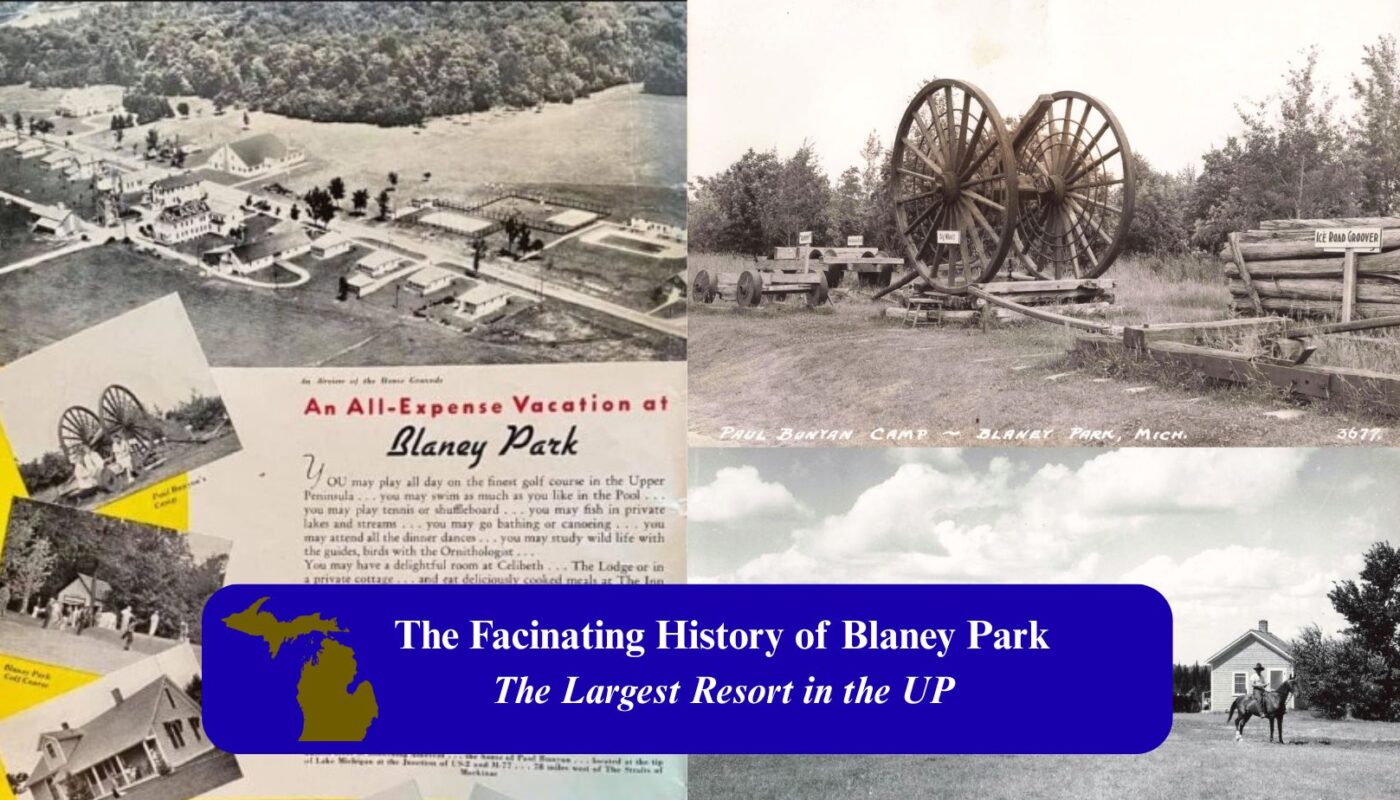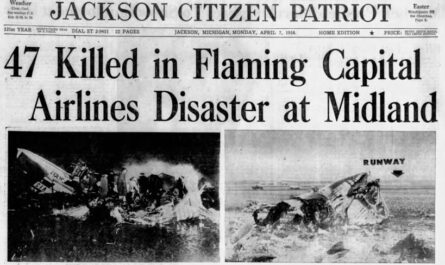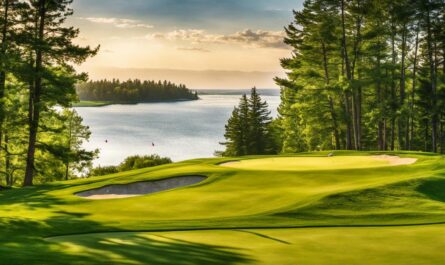Blaney Park, Michigan, is a unique community in the Upper Peninsula that evolved from a turn-of-the-century lumber camp into a famed tourist resort before fading into quiet obscurity. Located in Schoolcraft County near the junction of US-2 and M-77, the area began as “Blaney” in 1902 – a company logging town deep in the northwoods. By the late 1920s, its identity had undergone a transformation: the timber was gone, and in its place emerged one of the Upper Peninsula’s most ambitious vacation developments.
For a time, Blaney Park was renowned as a premier destination for recreation and leisure, drawing guests from across the Midwest. This structured timeline provides a comprehensive history of Blaney Park, with a focus on its tourism era, including its founding figures, resort development, ownership changes, notable events, and the economic and cultural impact on the region. Each era of Blaney Park’s story provides insight into broader trends in Upper Michigan’s economy and travel culture.
Table of Contents
Video – Blaney Park, Michigan: The Once-Premier Resort Town of the Upper Peninsula
Origins as a Lumber Town (1902–1926)
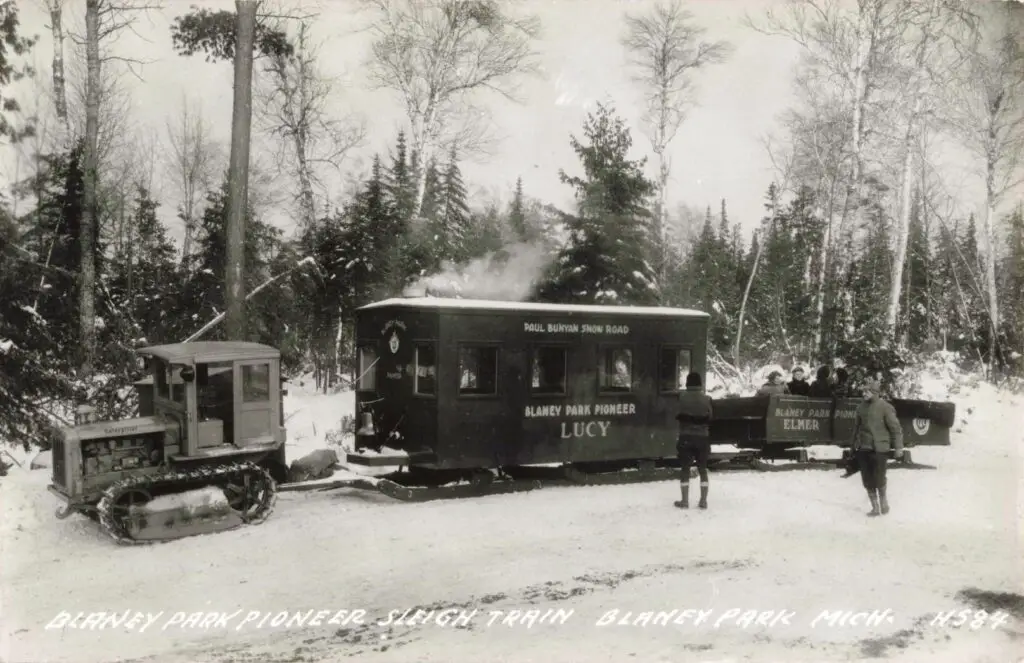
Blaney Park’s story begins with timber. In 1902, the Blaney settlement (then simply called “Blaney”) was established as a logging center by the McEacheran Lumber Company. Shortly thereafter, the William Mueller Company – a Chicago-based firm – took over operations, owning much of what became Mueller Township (named for William Mueller). The town was a classic Upper Peninsula company town with a mill, headquarters, worker housing, a general store, and a railroad connection for shipping lumber.
The George Earle Era
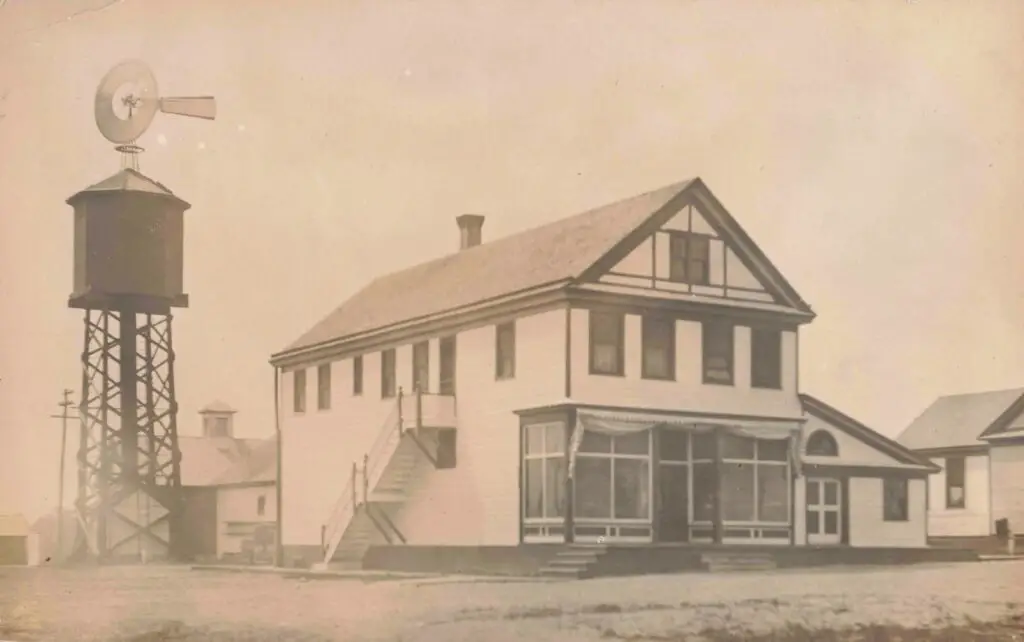
Logging thrived for only a few years. By 1909, with the prime timber largely cut, the Mueller Company sold the entire tract (nearly a whole township’s worth of land) to the Wisconsin Land and Lumber Company. This firm was owned by George Earle, who, along with his sons Harold and Stewart Earle, would profoundly shape Blaney’s future. The Earles continued logging through the 1910s and early 1920s, harvesting the remaining timber until around 1926. By then, the once-forested acreage had mainly been denuded – “cutover” land typical of the Upper Peninsula after the lumber boom.
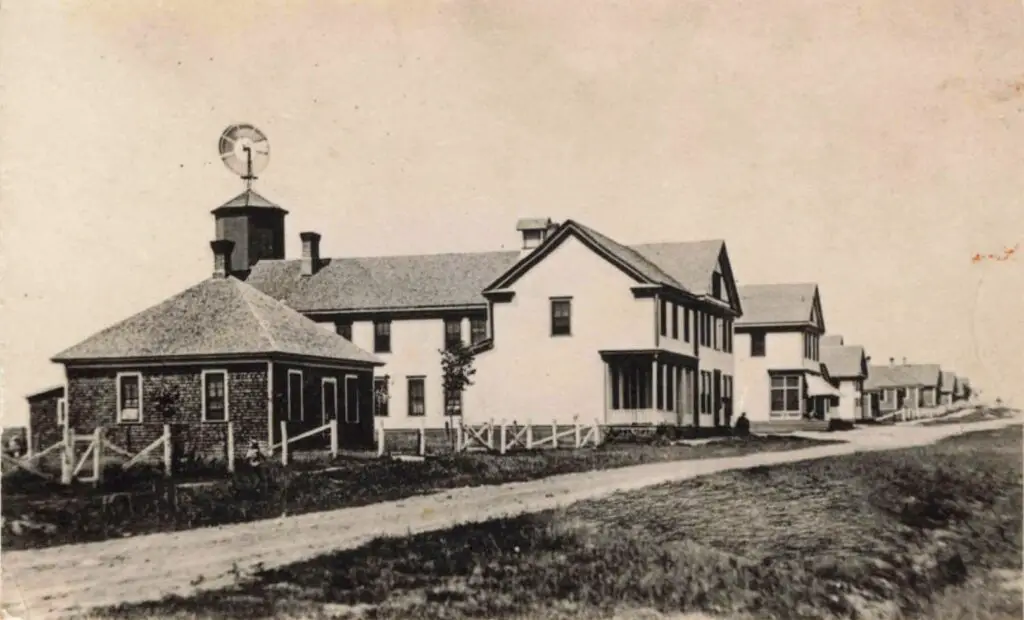
Rather than abandon the site, the Earle family saw an opportunity to repurpose it. In 1926, they initiated a bold transformation: the logging town would be transformed into a grand resort. Accordingly, the community’s name was changed from Blaney to Blaney Park, reflecting its new identity as a park-like vacation colony rather than an industrial camp.
From Stumps to A World-Class Resort
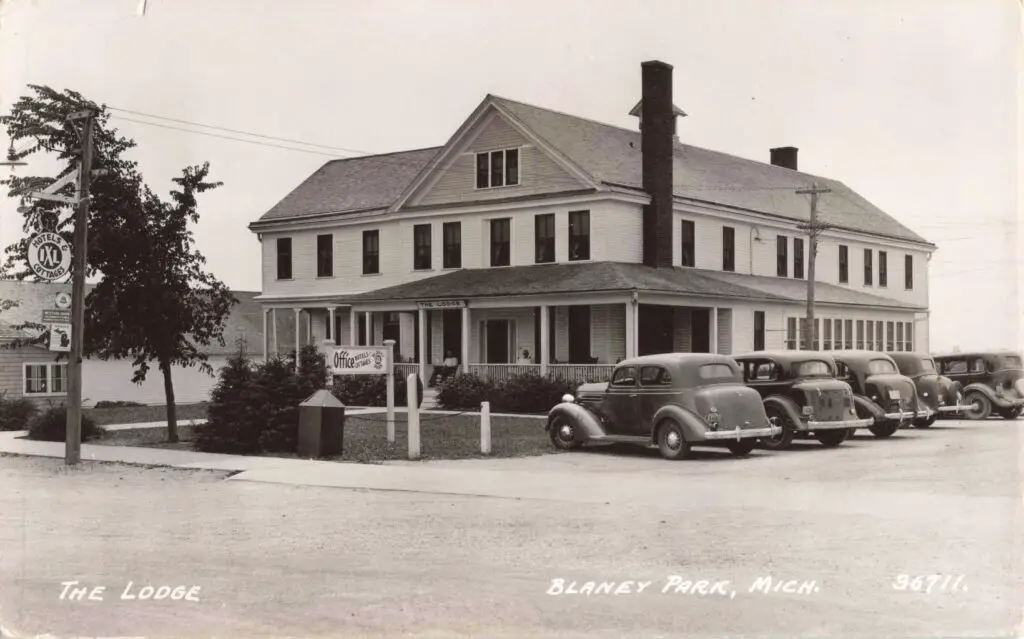
This early chapter set the stage for Blaney Park’s tourism era. Key figures included William Mueller (the lumber baron whose company founded the town) and the Earle family. Harold and Stewart Earle, guided by their patriarch, George Earle, were the visionaries who bankrolled and oversaw the transformation from sawmills to spas.
It was an audacious plan in an era when much of the Upper Peninsula was struggling with post-logging decline. But the Earles invested heavily, believing the natural beauty and climate of the U.P. could draw visitors just as it had drawn lumberjacks. As later noted by historians, Blaney Park’s trajectory from exploitation of natural resources to an attempt at tourism “development” was not an isolated case, but it was one of the most prominent examples in the region.
Transition to a Resort (1926–1930s)
By the late 1920s, Blaney Park was being refashioned into what would become the largest tourist development in the Upper Peninsula. The Wisconsin Land and Lumber Company ceased its milling operations and poured resources into creating a summer resort like no other.
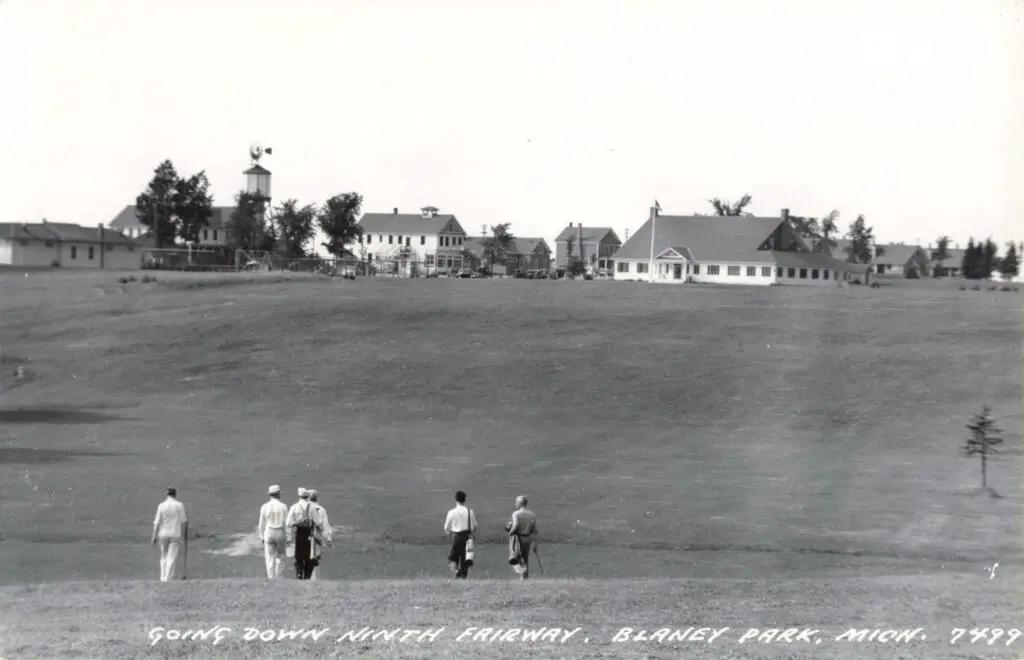
One of the first steps was to enhance the landscape for recreation: the Earles had a small lake engineered (named Lake Ann Louise after a family member) and a 9-hole golf course laid out on the former timber lands. In 1927, after these preparations, the resort officially opened its doors.
The Celibeth Clubhouse
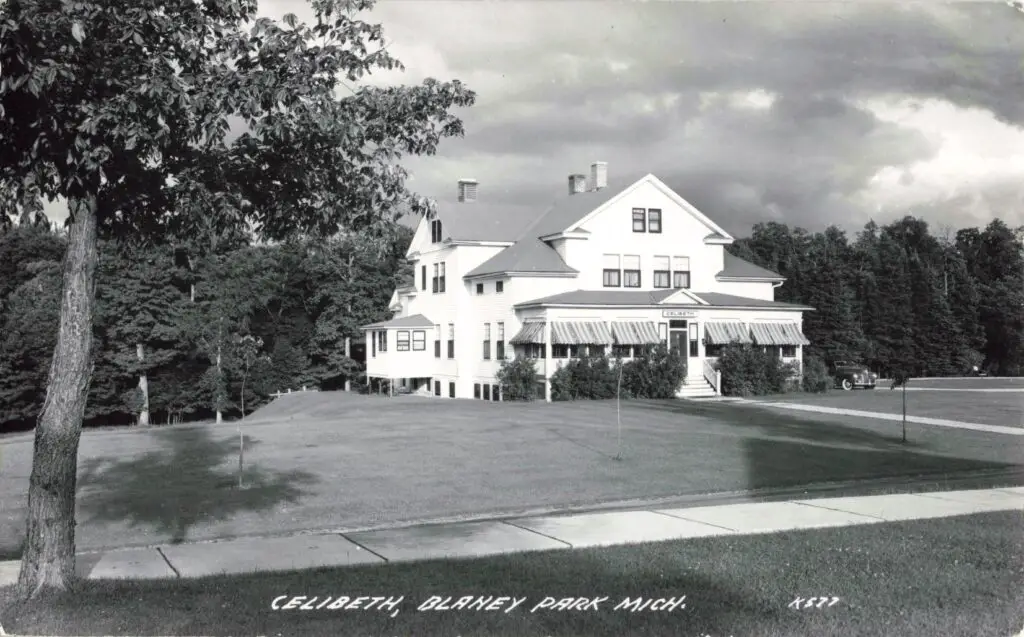
The very first guest facility was a quaint tavern/clubhouse called “Celibeth.” Opened in the heart of the village, Celibeth served as a combination inn, restaurant, and social hall for early visitors. The name “Celibeth” was a blend honoring two Earle daughters, Cecelia and Elizabeth. Notably, this building was formerly the Mueller family home, repurposed and expanded to accommodate paying guests. The Celibeth cottage’s debut in 1927–28 is often cited as the formal beginning of Blaney Park Resort.
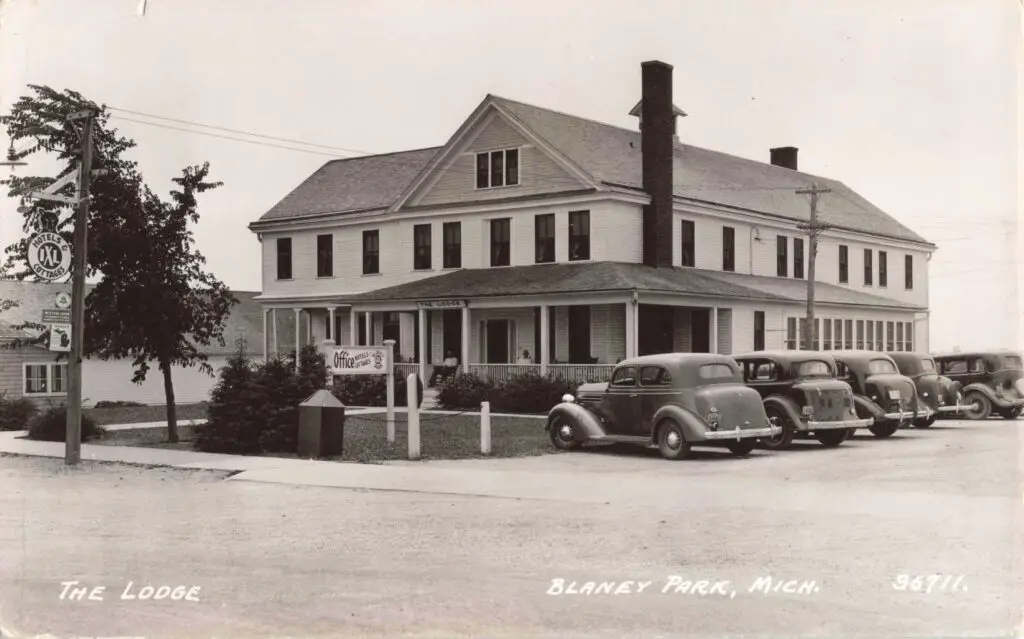
Over the next decade, the resort rapidly grew. The Earle brothers reinvested profits to add numerous facilities. Dozens of cottages sprang up, some converted from old lumber-era dwellings and others newly constructed for vacationers. In 1929, a larger main inn (often called Blaney Park Lodge or Inn) was built, providing about 14 guest rooms and dining space in a charming, rustic atmosphere. Throughout the early 1930s, development continued despite the Great Depression – testimony to the Earles’ deep pockets and commitment.
The Resort Village of Blaney Park
By the mid-1930s, Blaney Park was a “huge operation” with dozens of buildings spread across the property. Among these were guest cottages, staff housing, stables, and service buildings, forming a self-contained resort village. In 1938, the resort added a particularly distinctive touch: a cluster of Colonial Revival–style cottages, painted white with green shutters, was built about a mile from the main lodge area. These charming cottages, reminiscent of a New England village transplanted to the North Woods, were designed to attract upscale clients and long-term summer residents.
Setting for an Upscale Clientele
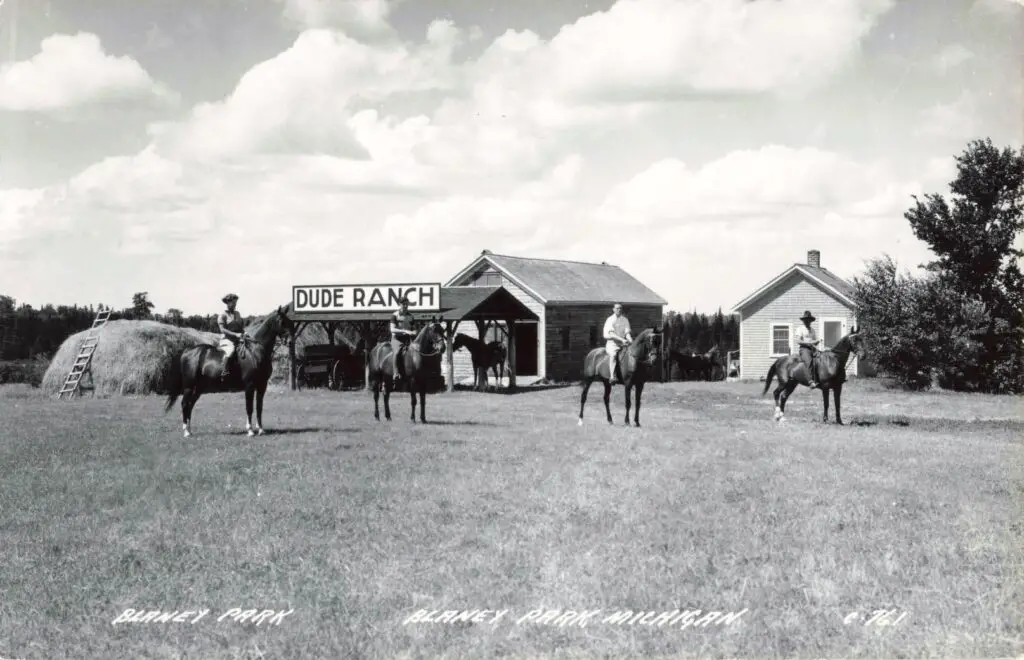
By the end of the 1930s, Blaney Park Resort could boast an array of amenities rarely seen in the U.P. at the time. Guests had at their disposal the golf course and tennis courts, a private lake for fishing and paddling, bridle trails for horseback riding, and even a landing strip for private planes. Indeed, Blaney Park built its own small airport – a 2,500-foot grass runway – so that wealthy visitors could fly directly into the resort. This foresight paid off, as some guests did arrive by small aircraft, while others came by rail to the nearby Blaney Junction depot or by automobile as roads improved. In an era when much of the Upper Peninsula remained remote, Blaney Park was starting to put itself on the map as an accessible yet secluded retreat.
Heyday of Blaney Park Resort (1940s–1950s)
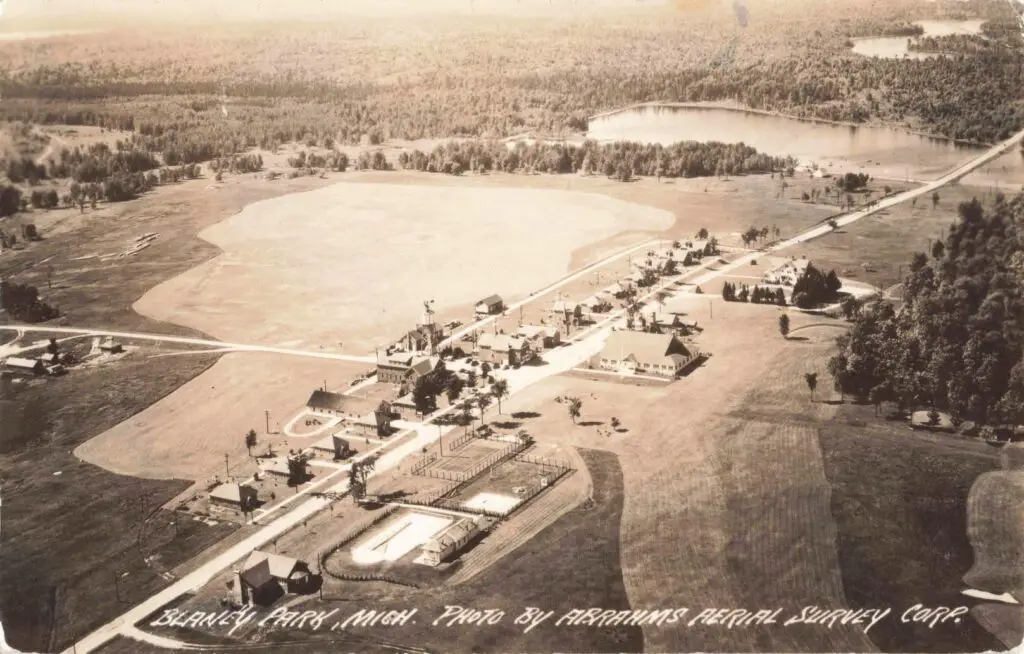
Blaney Park reached the peak of its popularity in the 1940s and 1950s, when it earned a reputation as the Upper Peninsula’s “premier resort”. During these decades, the resort was in full swing every summer season (and even in winter for hunting and snow sports). Middle-class and affluent vacationers flocked here, typically arriving by car via US-2 and M-77 once post-war highway travel became easier.
A Home Away From Home
Many families from Michigan, Wisconsin, Illinois, and the Midwest would drive north to Blaney Park and stay for several weeks at a time, making it their home away from home in the cool northern woods. The resort’s remote location and expansive grounds (spanning roughly 33,000 acres in total) gave it an exclusive, almost self-contained atmosphere. Blaney Park marketed this breadth as part of its appeal – a place with “33,000 acres of something different,” as a promotional slogan of the era touted. Wealthy guests and even celebrities valued the privacy; with 54 square miles of land, there was plenty of room to “escape the public” eye in Blaney’s secluded environs.
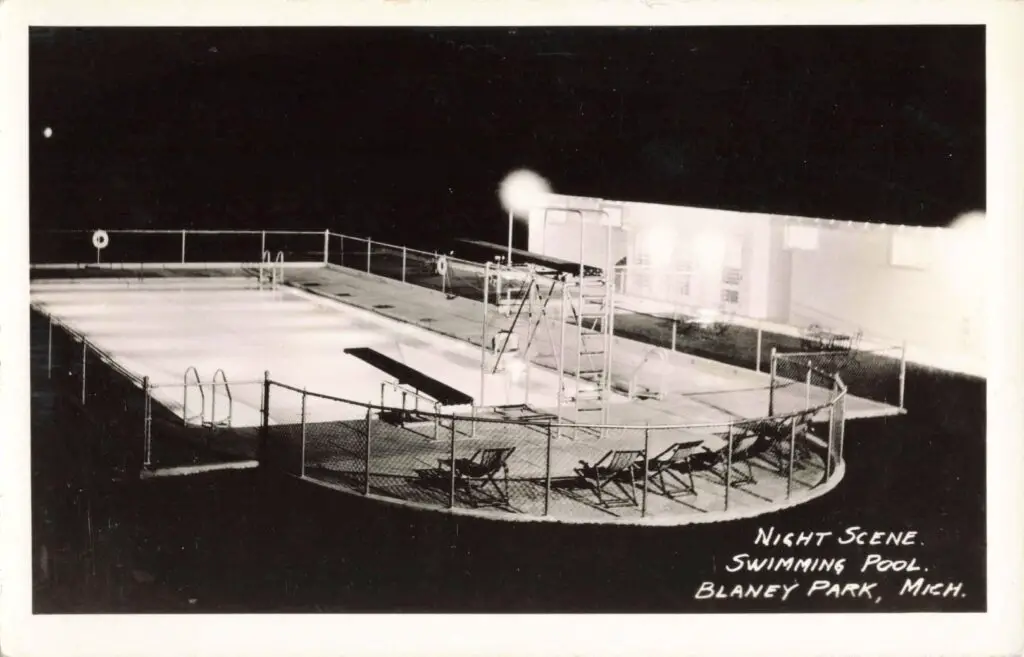
Tourism activities at Blaney Park were remarkably diverse, offering “something for everyone,” as locals fondly recalled. By day, guests could enjoy horseback riding on a dude ranch, swimming and sunning by what was reportedly the only heated swimming pool in the U.P. at the time, golfing on the resort’s sporty course, archery, tennis, shuffleboard, and guided outings for hunting, fishing, and trapping in the surrounding forests.
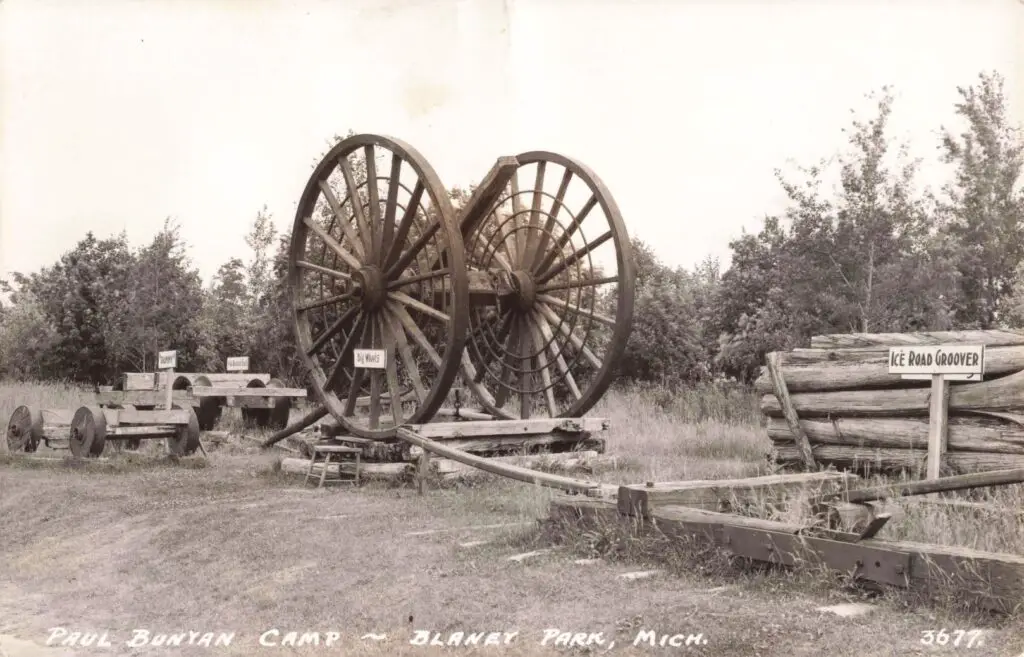
There was even a “Paul Bunyan” lumberjack camp exhibit during the 1940s, nodding to the site’s logging past, and a bird sanctuary to attract wildlife for nature-loving guests. In the evenings, Blaney Park was famous for its hospitality and entertainment. The main lodge featured fine dining – “absolutely, positively gourmet food,” as one former staff member remembered it – with an elaborate lunchtime smörgåsbord that drew visitors from miles around. Saturday nights were gala affairs: guests would “come for the food and stay for the entertainment”.
High End Entertainment in the North
The resort maintained a tradition of live dance bands playing swing and jazz, and the young resort staff would put on weekly variety skits – telling jokes, singing, and dancing – much to the delight of patrons. Dr. Jim Surrell, who worked as Blaney’s social director in the early 1960s, later described how the staff and guests mingled like family, with a convivial atmosphere fostered by the Earle family’s welcoming policies.
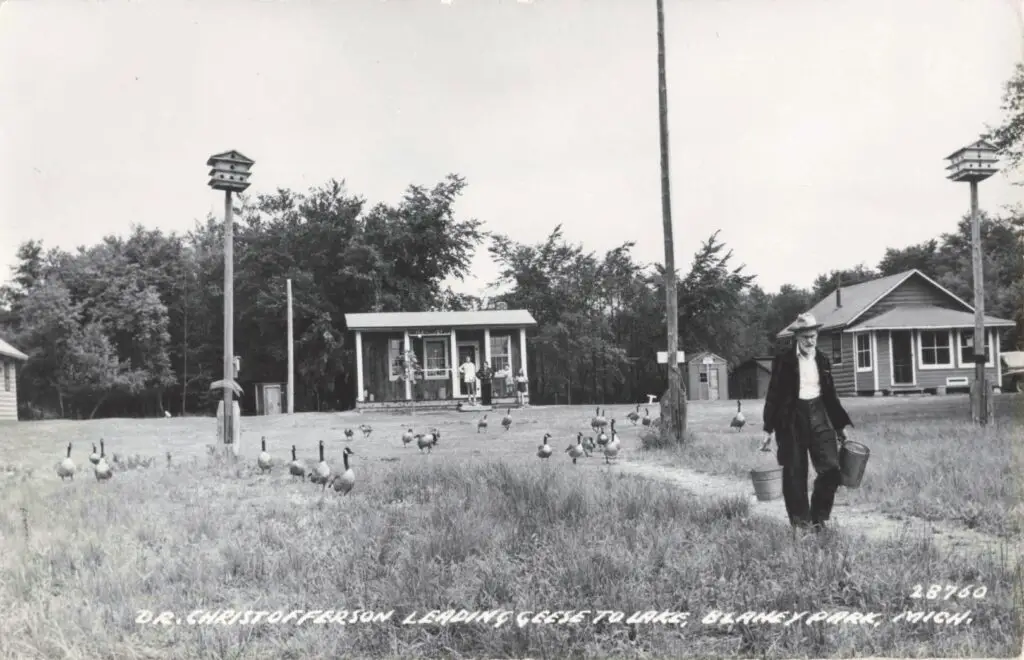
Blaney Park in this era attracted an array of notable visitors. It was “legendary” among celebrities and the wealthy in the mid-20th century. Movie stars and public figures could vacation there discreetly; however, local lore has it that the community kept their secrets – few records remain of which famous names stayed at Blaney, as locals tended not to gossip about their high-profile guests.
What is clear is that Blaney Park was the destination of choice for a specific group of Midwestern travelers during the post-World War II era. It combined rustic charm with modern luxuries, bringing much-needed tourism revenue to a remote part of Michigan. The resort at its height employed a significant number of residents and seasonal workers (college students frequently staffed the summer operations). For approximately two generations, from the late 1920s through the 1950s, Blaney Park Resort successfully reinvented a defunct lumber town into a vibrant engine of the regional tourism economy.
As Surrell noted, it was “the premier summer resort for about 40 years” – arguably not just in the U.P. but in the entire Midwest. The economic impact on the surrounding area was substantial: Blaney Park drew in thousands of visitors whose spending benefited Mueller Township and beyond, at a time when many other former lumber towns had all but disappeared. The resort’s success story, however, would not last forever.
Decline and Closure (1960s–1980s)
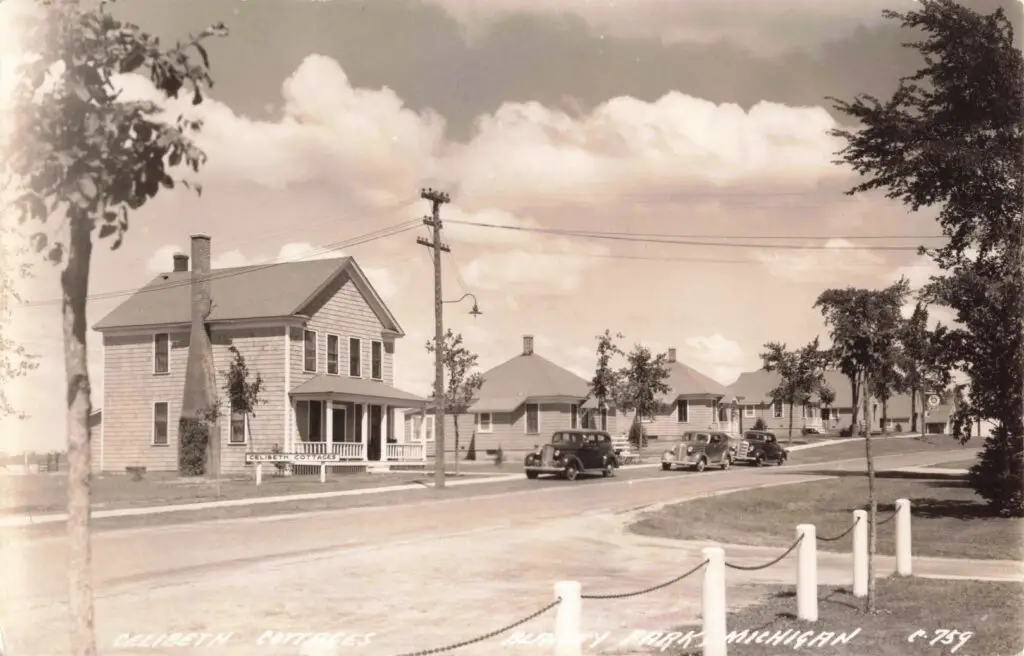
In the 1960s, Blaney Park entered a period of decline as sweeping changes in travel habits and infrastructure reshaped the American tourism landscape. After 40 prosperous years, the resort found itself increasingly out of step with the times. One major factor was the development of the interstate highway system and other improved roads in the late 1950s and 1960s. Whereas Blaney Park had once benefited from its relative isolation (encouraging guests to stay put for weeks), the new highways made it easy for vacationers to zoom directly to far-off destinations.
The same family from Illinois that might have spent two weeks in the U.P. during the 1950s could, by the late ’60s, drive to Florida or the East Coast in a similar span of time. As Surrell explained, “there weren’t a lot of expressways when [Blaney] was in its heyday… people would go somewhere and stay for a couple of weeks”, but once high-speed roads existed, tourists began seeking more variety and traveling farther afield. Similarly, the advent of affordable jet air travel in the 1960s enabled Americans to fly to new, “exotic” locations – such as tropical beaches and foreign countries – rather than summering in the same familiar northern resort each year. Blaney Park’s remote charm suddenly became a liability: it was now possible to get beyond the U.P. quickly, and many travelers did exactly that.
The Beginning of the End for Blaney Park
The resort’s business tapered off through the early 1960s. Longtime owner Stewart Earle, who had devoted much of his life to Blaney Park, realized that the operation was no longer sustainable in this new era of travel. The big bands fell silent, and the dining room saw more empty tables, resulting in a drop in occupancy rates. By 1963, the Earles decided to shut down regular resort operations. The Blaney Park Resort officially closed its doors in 1963–64, with Stewart Earle’s retirement following shortly after. (News reports at the time noted that closing Blaney Park – long advertised as “33,000 acres of something different” – would also mark the end of Earle’s remarkable career.) Thus, after nearly four decades, the era of champagne toasts and summer galas in the northern woods came to an end.
Blaney Park did not disappear overnight, but it underwent dramatic changes after its closure. The large property remained in the Earle family for a while, although it was used much less. A skeleton crew maintained some facilities for a time; the general store and gas station in the village stayed open to serve local needs, even as the grand lodge ceased welcoming guests.
Blaney Park is Broken Up and Sold
Stewart Earle eventually arranged to sell off the vast Blaney Park estate in the late 1970s. The once-unified 33,000-acre property was likely too large for a single buyer by then, and it passed through a period of legal limbo and auctions. In the early 1980s, the remaining assets of Blaney Park – land, buildings, and infrastructure – were auctioned off in pieces to various private owners. This effectively dismantled the resort as a single entity. Different portions of Blaney Park were repurposed: some cabins and cottages were converted into private summer homes or hunting camps, and parcels of the forest were sold for timber or conservation.
By the 1980s, Blaney Park was a Ghost Town
The economic impact of Blaney Park’s decline was felt in Mueller Township. Jobs and tourism dollars that the resort had generated dried up. The local population dwindled as young people left to find work elsewhere. By the mid-1980s, Blaney Park had largely become a ghost town in appearance – a shadow of its former self. A reporter visiting decades later described “forgotten glory” fading away: the once-busy Olympic-size swimming pool sat empty, collecting algae; the tennis courts and shuffleboard lanes were overgrown with moss; and the idyllic golf fairways had turned back into a cedar grove. Only a handful of residents remained amid the aging buildings. In many ways, Blaney Park’s fate in the 1960s–80s mirrored that of other single-industry U.P. towns – first a boom, then bust. As historian Ted Bays observed, this resort’s trajectory from “founding to foundering” was “typical of U.P. history”, echoing how broader economic shifts can dramatically reshape small communities.
Later Years and Legacy (1990s–Present)
Although Blaney Park, as a grand resort, was gone, its story did not end with the auction block. In the ensuing decades, the location found a modest second life and remains part of Upper Michigan’s tourism landscape, albeit on a far smaller scale. Many of the historic buildings survived and were gradually reoccupied or restored by individual owners. For example, the original Celibeth Cottage – the first resort building – still stands today; it even operated as a bed-and-breakfast inn for several years in the 2000s, giving modern visitors the chance to sleep in a piece of Blaney Park history.
The main Blaney Park Lodge also endured: decades after the resort’s closure, the lodge was run as a simple roadside motel/inn by a local couple well into the 2000s. Travelers could stop over and get a room with breakfast, a faint echo of the resort’s hospitality (one travel writer in 2010 was astonished to find the elderly proprietor, Howard, still offering rooms “with private baths… at $39 a night, including homemade breakfast and pie and ice cream in the evening”). These small-scale operations, along with a few antique shops and rustic cabin rentals (such as today’s Bear Creek Resort cabins), keep Blaney Park on the map for curious tourists driving through the area.
Visiting Blaney Park now is a markedly different experience from its mid-century heyday. The atmosphere is quiet and a bit mysterious – “a small well-worn town, pop. ~50, figuratively in the middle of nowhere,” as one account described it. Remnants of the resort’s past are visible if one knows where to look: the concrete shell of the big swimming pool, the outlines of the tennis courts, and a few fading signs pointing to what were once lodges or attractions. A number of the white Colonial Revival cottages still dot the landscape, now used as private summer homes. The Blaney airstrip also endures; remarkably, the grass runway remains usable for small planes, a testament to the resort’s enduring legacy. In recent years, local history enthusiasts and former patrons have sought to preserve the memory of Blaney Park.
Reunions have been organized – notably a staff reunion in 2007 that drew about 150 former employees and family members back to reminisce. Their shared stories underscore the deep nostalgia for the place. Articles in regional publications (e.g., Michigan History magazine and the Mining Journal) have recounted Blaney Park’s rise and fall, and a small historical exhibit exists in Schoolcraft County. The Bear Creek Resort website, run by current local cabin proprietors, actively collects oral histories and photographs, aiming to create a comprehensive record of Blaney Park’s golden years.
Blaney Park Lodge Burns 2018
Today, Blaney Park’s legacy is twofold. First, it stands as a fascinating chapter in Michigan’s tourism history – an example of how industrialists attempted to pivot from a depleted natural resource (lumber) to a new economic base (vacation travel) in the early 20th century. For a time, that gamble paid off, and Blaney Park became a jewel of the U.P.’s tourist destinations. Second, its story serves as a cautionary tale about changing times.
The resort that was once “the premier resort in the entire Midwest” could not withstand the changing tides of transportation and leisure in the 1960s. In the broader context, as the Upper Peninsula’s economy shifted, many communities had to reinvent themselves; Blaney Park did so once (logging to tourism) but couldn’t do so a second time when tourism patterns changed. Nonetheless, the community has never completely vanished. It still welcomes adventurous visitors – those willing to wander off the main highway to find a quiet cluster of old buildings and perhaps feel the echoes of jazz music and laughter from summers long past.
In summary, the timeline of Blaney Park spans over a century, from its founding in 1902 as a lumber camp, through its heyday in the 1920s and 1950s as a sprawling resort, to its closure in the 1960s and its aftermath, and into its present-day quietude. The economic and social impact of Blaney Park was significant during its prime, as it injected jobs, tourism, and culture into a remote area. Its decline, likewise, left a void. Yet, the physical place persists, and so do the stories. Blaney Park’s rise and fall encapsulate the boom-and-bust cycles of the region. As one historian aptly noted, Blaney Park’s history is a microcosm of Upper Peninsula history, reflecting both the grandeur and the challenges of an era. Its legacy lives on in the memories of those who experienced it and in the ongoing efforts to document and share its remarkable story.
Sources for the History of Blaney Park
Buchmann, Nicole. “Restoring Blaney Park’s History in Rental Cottages.” WLUC TV6 News, 28 May 2018. Web.
“Celibeth House B & B.” Pure Michigan (Michigan.org), n.d. Web.
Eckert, Kathryn Bishop. “Blaney Park.” SAH Archipedia, Society of Architectural Historians, 2012. Web.
“History of Blaney Park.” Manistique Centennial Book (1960). Reproduced on Schoolcraft County Genealogy Trails (genealogytrails.com). Web.
“Mueller Township’s Blaney Park Resort.” Schoolcraft County Historical Society, n.d. Web.
Robinson, John. “The Historic Michigan Lumber Town of Blaney Park, Then & Now.” 99.1 WFMK, 1 Apr. 2020. Web.
“Blaney Park History.” Bear Creek Resort at Blaney Park, n.d. Web.
“Blaney Park.” Miningjournal.Net, The Mining Journal, 22 Feb. 2018
“Blaney Park Resort – Part One.” Rural Insights, 27 Oct. 2021, ruralinsights.org/content/blaney-park-resort-part-one/. Accessed 28 Sept. 2025.
In the digital collection David V. Tinder Collection of Michigan Photography. William L. Clements Library, University of Michigan Library Digital Collections. September 27, 2025.

